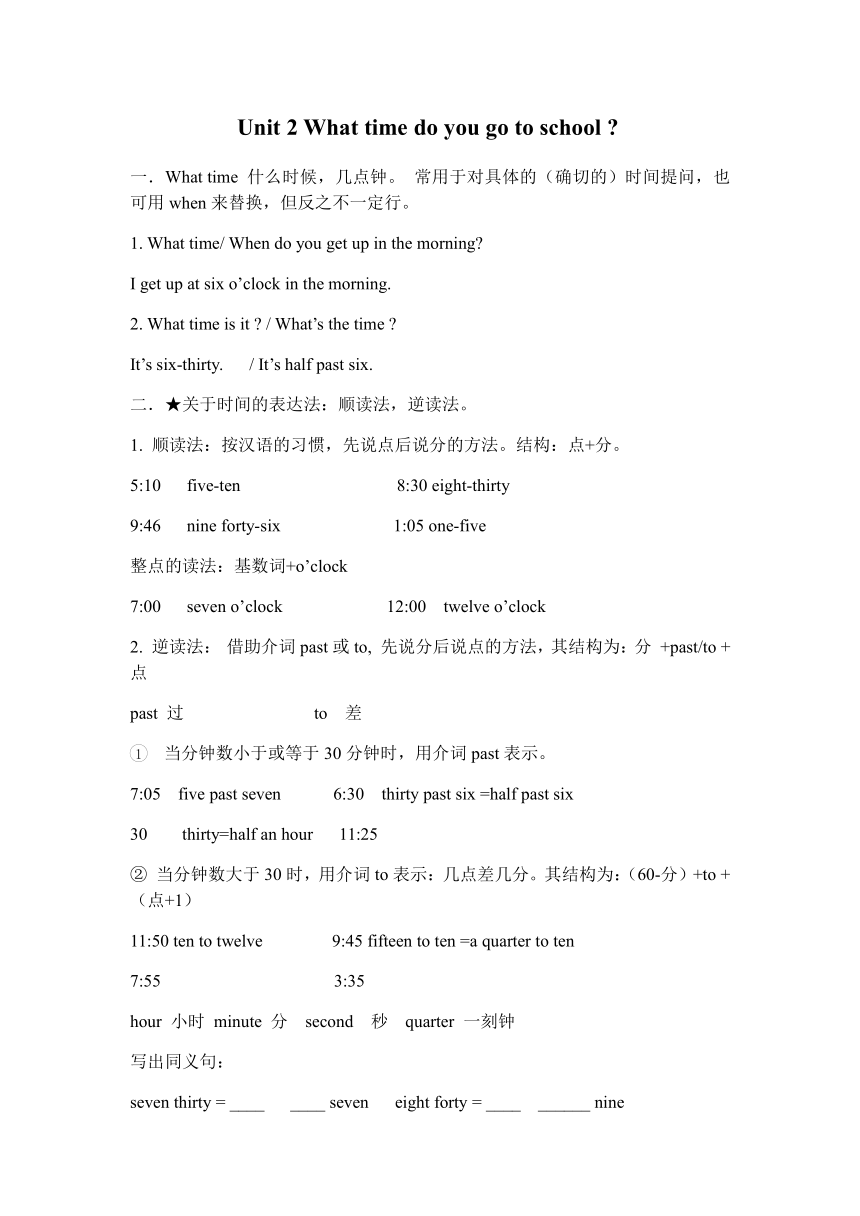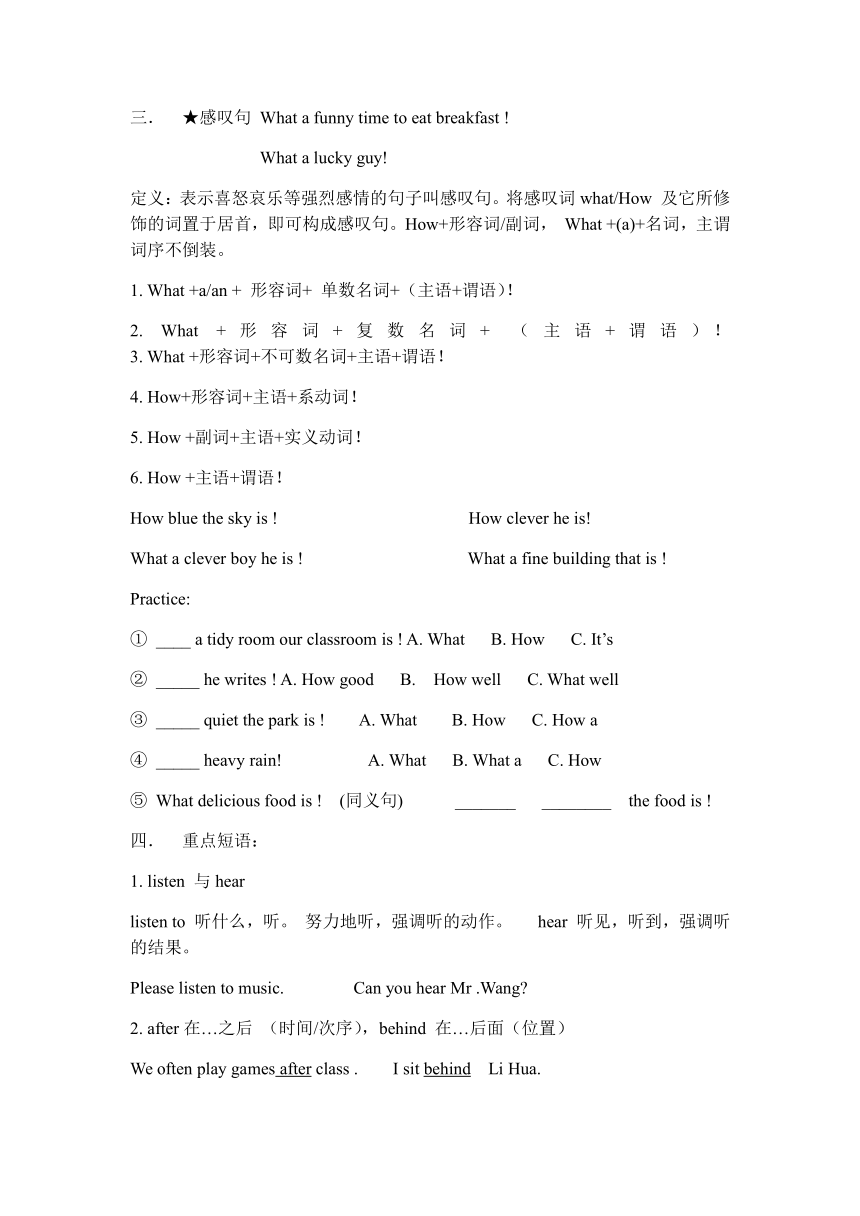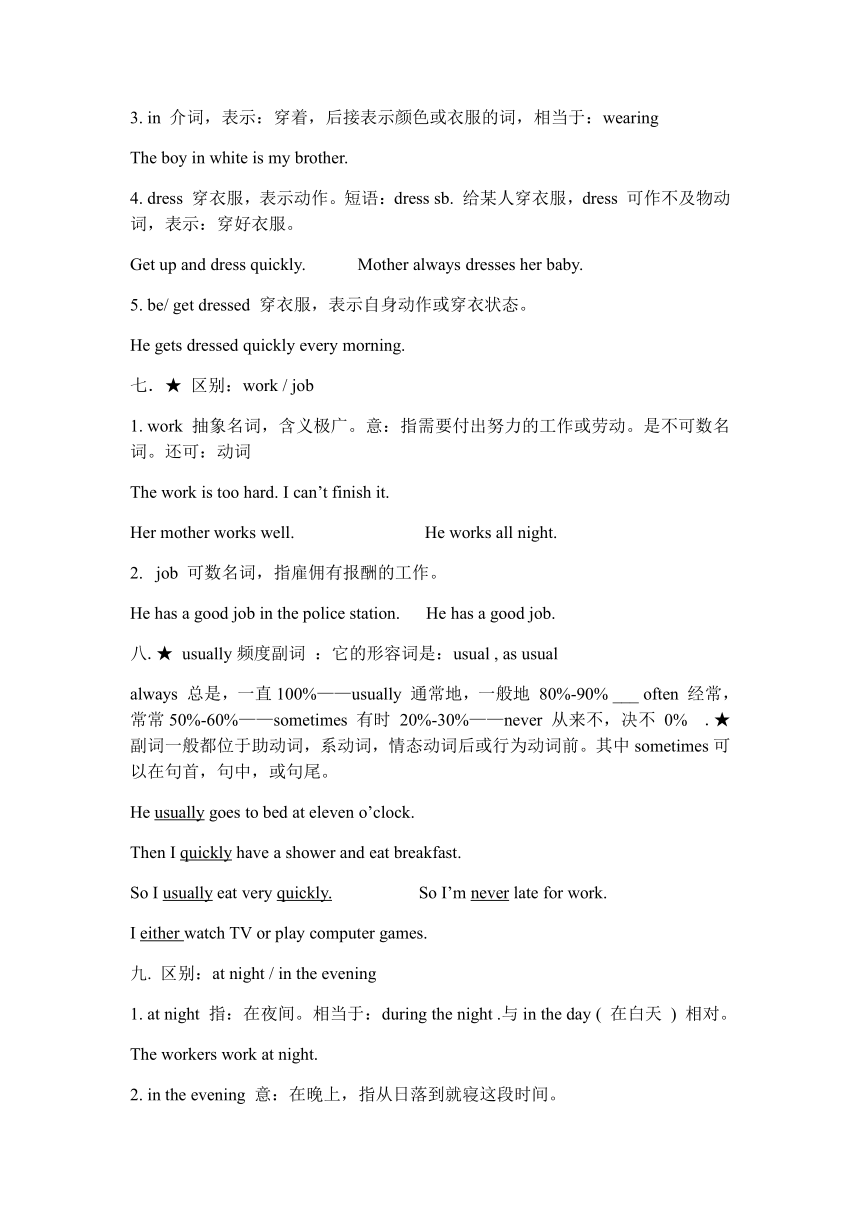人教版七年级下英语Unit 2 What time do you go to school 复习学案
文档属性
| 名称 | 人教版七年级下英语Unit 2 What time do you go to school 复习学案 |  | |
| 格式 | zip | ||
| 文件大小 | 42.5KB | ||
| 资源类型 | 教案 | ||
| 版本资源 | 人教新目标(Go for it)版 | ||
| 科目 | 英语 | ||
| 更新时间 | 2020-02-04 20:05:24 | ||
图片预览




文档简介
Unit 2 What time do you go to school ?
一.What time 什么时候,几点钟。 常用于对具体的(确切的)时间提问,也可用when来替换,但反之不一定行。
1. What time/ When do you get up in the morning?
I get up at six o’clock in the morning.
2. What time is it ? / What’s the time ?
It’s six-thirty. / It’s half past six.
二.★关于时间的表达法:顺读法,逆读法。
1. 顺读法:按汉语的习惯,先说点后说分的方法。结构:点+分。
5:10 five-ten 8:30 eight-thirty
9:46 nine forty-six 1:05 one-five
整点的读法:基数词+o’clock
7:00 seven o’clock 12:00 twelve o’clock
2. 逆读法: 借助介词past或to, 先说分后说点的方法,其结构为:分 +past/to +点
past 过 to 差
1 当分钟数小于或等于30分钟时,用介词past表示。
7:05 five past seven 6:30 thirty past six =half past six
30 thirty=half an hour 11:25
② 当分钟数大于30时,用介词to表示:几点差几分。其结构为:(60-分)+to +(点+1)
11:50 ten to twelve 9:45 fifteen to ten =a quarter to ten
7:55 3:35
hour 小时 minute 分 second 秒 quarter 一刻钟
写出同义句:
seven thirty = ____ ____ seven eight forty = ____ ______ nine
3. ★感叹句 What a funny time to eat breakfast !
What a lucky guy!
定义:表示喜怒哀乐等强烈感情的句子叫感叹句。将感叹词what/How 及它所修饰的词置于居首,即可构成感叹句。How+形容词/副词, What +(a)+名词,主谓词序不倒装。
1. What +a/an + 形容词+ 单数名词+(主语+谓语)!
2. What +形容词+复数名词+ (主语+谓语)! 3. What +形容词+不可数名词+主语+谓语!
4. How+形容词+主语+系动词!
5. How +副词+主语+实义动词!
6. How +主语+谓语!
How blue the sky is ! How clever he is!
What a clever boy he is ! What a fine building that is !
Practice:
① ____ a tidy room our classroom is ! A. What B. How C. It’s
② _____ he writes ! A. How good B. How well C. What well
③ _____ quiet the park is ! A. What B. How C. How a
④ _____ heavy rain! A. What B. What a C. How
⑤ What delicious food is ! (同义句) _______ ________ the food is !
4. 重点短语:
1. listen 与hear
listen to 听什么,听。 努力地听,强调听的动作。 hear 听见,听到,强调听的结果。
Please listen to music. Can you hear Mr .Wang?
2. after在…之后 (时间/次序),behind 在…后面(位置)
We often play games after class . I sit behind Li Hua.
3. around 与about 作:大约时,可以替换。 around 副词,意为:到处。(here and there )
about 介词,意为:关于。此时两者不能替换。
My father often drives a car around . I learn about Chinese history.
4. take a shower = have a shower take a bus =…by bus
take a rest= have a rest take a walk=have a walk
take a look= have a look
5. get to school get to work get to Luzhou get there /get here/ get home
小结:go/get+介词+地点名词 go/get +副词 (要省介词to)
6 . go to school 去上学 go to the school去学校
come to school 来学校 go to work去上班go to bed 上床睡觉
have a parents meeting 开家长会 go to college 上大学
7. do one’s homework = do homework
homework/ housework/work….为不可数名词。 one’s 常用形容词的物主代词。
He does his homework at 6:00. He doesn’t ______ his homework at 6:00.
5. 交际用语:
1. What time do you usually get up ? I get up at six o’clock.
2. When does Lucy take a shower ? She takes a shower at five o’clock.
3.When do your friends exercise ? They usually exercise on weekends.
4. For lunch/For breakfast/For dinner, we usually eat hamburgers.
六.★区别:put on, wear, in ,dress, be/ get dressed
1. put on 穿上,戴上。强调穿衣的动作。其反义词是脱下:take off
Please put on your sweater.
2. wear 穿着,戴着,强调穿的动作。
My teacher is wearing a red skirt today.
3. in 介词,表示:穿着,后接表示颜色或衣服的词,相当于:wearing
The boy in white is my brother.
4. dress 穿衣服,表示动作。短语:dress sb. 给某人穿衣服,dress 可作不及物动词,表示:穿好衣服。
Get up and dress quickly. Mother always dresses her baby.
5. be/ get dressed 穿衣服,表示自身动作或穿衣状态。
He gets dressed quickly every morning.
七.★ 区别:work / job
1. work 抽象名词,含义极广。意:指需要付出努力的工作或劳动。是不可数名词。还可:动词
The work is too hard. I can’t finish it.
Her mother works well. He works all night.
2. job 可数名词,指雇佣有报酬的工作。
He has a good job in the police station. He has a good job.
八.★ usually频度副词 :它的形容词是:usual , as usual
always 总是,一直100%——usually 通常地,一般地 80%-90% ___ often 经常,常常50%-60%——sometimes 有时 20%-30%——never 从来不,决不 0% .★ 副词一般都位于助动词,系动词,情态动词后或行为动词前。其中sometimes可以在句首,句中,或句尾。
He usually goes to bed at eleven o’clock.
Then I quickly have a shower and eat breakfast.
So I usually eat very quickly. So I’m never late for work.
I either watch TV or play computer games.
九. 区别:at night / in the evening
1. at night 指:在夜间。相当于:during the night .与in the day ( 在白天 ) 相对。
The workers work at night.
2. in the evening 意:在晚上,指从日落到就寝这段时间。
I watch TV in the evening.
十. 区别:fun/ funny 共同点:都可作形容词。
1. fun 意:愉快的。 fun 还可作:名词,意:乐趣。常用结构: have fun ( doing sth. )= have a good time
I have a fun night in the club.
2. funny 意:有趣的 (事物),只作形容词。
That’s the funniest joke. I heard a funny noise.
十一.★ exercise 用法:(exercise—exercising )
1. 动词,运动,锻炼,使…得到锻炼。
I exercise every morning.
2. 名词,不可数名词时,意为:锻炼,运动,练习。作可数名词时,意:练习题,体操
Dancing is good exercise. He takes exercise every day.
3. 固定短语:do morning exercises 做早操, do eye exercises 做眼保健操, take more exercise 多锻炼, do/ take exercise = do sports 进行运动,锻炼身体, do some exercises 做练习
十二. 介词用法:on/ in/ at/ for / from.. to
1. on 用于具体某一天,指日期,某天某段时间,具体某天,纪念日,节日。
短语:On Sunday, on the morning of last Monday , On National Day.
2. in 用在月份/ 季节/ 年代/ 世纪前 和一些固定短语:in the morning/ in the afternoon/ in the evening 等。
短语:in Winter/Spring/Summer/Autumn , in the 20th century
3. at 用在表示确切的时间点,在某时刻,用于年龄, 用在特定的时候(时节,时机)时,须用介词at .
at five o’clock, at noon, at this time, at the age of 14
At the age of 5, the boy could swim well .
What do you often do at noon ?
4. for 用来表示一段时间,后常跟具体的时间段。还可表示:对于,就…而言。用于三餐前。
for three days, for five years
短语: have … for breakfast/ lunch/ supper/ dinner
We have chicken for dinner.
5. from… to 从…到..
We go to school from Monday to Friday.
How far is it from Beijing to Hainan?
十三. half 的用法:
1. 名词或代词。意:一半,半数,是可数名词,其复数形式:halves
Cut the apple into halves.
2. 表示:某物的一半,用结构:half a/ an + 单数名词。
半小时:half an hour 半千克:half a kilo
半个橘子:half an orange 半天:half a day
半月:half a month 半年: half a year
3. half 用于一个或一个以上整数再加一半,表示:几个半。用结构:one ( two…..) + 名词 + and a half 或者:one ( two… ) and a half
注意:名词复数形式的变化。
一个半小时: one hour and a half 或 one and a half hours
4. 注意:half of +名词 作主语时,后接单数可数名词/ 不可数名词或代词宾格时,谓语动词用单数,若接复数可数名词或代词宾格时,谓语动词用复数。
Half of his money is lost. Half of the books are novels.
十四. 区别:past/ pass ( go past= pass )
1. past 介词。意:过,经过
The man went past the gate of our school.
2. pass 动词,意:过,经过
The man passed the gate of our school.
十五. 区别:quickly/ fast/ soon
1. quickly 副词,快地,迅速地,指某动作迅速地发生或完成,具有即刻行动,毫不耽误之意。
He quickly jumped onto the bank of the river.
2. fast 形容词或副词。快的(地),迅速的(地),强调速度快。
You’re walking too fast. I can’t keep up with you.
3. soon 副词,很快,马上,强调的是时间,即不久以后将发生的某个动作或某种情况。
He’ll be back soon.
十六. either 的用法:
1. 副词,或者,也。(用在否定句后)
I don’t like math, he doesn’t like it, either.
2. 也可作:形容词或代词,在句中作主语时,后面的谓语动词一般用单数。
Either ( of them ) is OK. Either of the books is good.
3. either 也可作定语,它后面被修饰的名词要用单数。
There are many trees on either side of the street.
4. ★either… or 或者…或者,要么…要么,当连接两个名词作主语时,后面的谓语动词要用:就近一致的原则。
Either he or I am coming. I either watch TV or play computer.
十七.★ 区别:a lot of / lots of / a lot
1. a lot of = lots of 许多,大量, 常用于肯定句中,修饰可数或不可数名词。 在疑问句或否定句中常用much/ many 代替a lot of.
I have a lot of / lots of homework to do.
2. a lot 相当于very much ,意:许多,非常,十分。a lot 强调程度,可修饰动词,放在动词后或句末,也可修饰比较级。(much, far, even 等)
I like him a lot. He is a lot taller than I/ me.
十八. 区别:have / eat/ take/ drink
1. have 指:吃,喝时,在三餐前使用,它相当于eat. have 还有其他意思:有等
2. eat 吃,指吃具体的食物,表示:喝时,指喝汤。(eat_ate_eatten)
I ate a lot of sweets. My father likes to eat soup.
3. take 作吃,喝讲时,叫生硬,不如have, eat 正式。若指吃药时只用take
Take this medicine, and you’ll be OK.
4. drink 作动词时,表示:喝得动作,后跟表示水,茶等饮品的名词。它还有:饮酒之意,此时drink 后常跟表示酒的名词。
I like to drink beer.
十九 .区别: go to bed/ go to sleep/ sleep/ be asleep
1. go to bed 指:就寝,只表示:上床去睡觉,无睡着之意,是终止性动词短语。它的对应词是:起床( get up )
I have to go to bed before 11 o’clock.
2. go to sleep 作:去睡觉讲时,它相当于:go to bed, 还有其他意思: 睡觉,入睡,强调动作的结果,即睡着了。
He was so tired that he went to sleep soon.
3. sleep 可作:延续性动词,表示:睡觉,它也可作名词,表示:睡眠。(sleep_ slept_ slept)
My father is sleeping now.
I had a long sleep on weekend.
4. be asleep 形容词,意:睡着的,作表语,强调状态时,指:睡着。
Look! The boy is asleep with his cute toy.
二十.★区别:sometimes, sometime, some time, some times
1. sometimes 意:有时。副词
Sometimes he comes by bike and sometimes on foot.
2. sometime 副词,意: 在某个时候,可用于一般过去时与将来时。
You can hand in your homework sometime before Friday.
3. some time 名词短语,意: 一段时间
I’ll be away for some time.
4. some times 也是名词短语,意:几次。time 在这是可数名词
I have been to the West Lake some times.
二十一.重点短语
1.起床 2. 穿衣服 3. 洗淋浴
4.迟到 5. 上班迟到 6. 吃早餐
7.一份有趣的工作 8. 在早上/上午 9. 在上学的日子
10.三点一刻 11. 六点四十五分 12. 回家
13.上床睡觉早 14.做运动 15. 半小时
16. 尝起来可口 17. 从…到 18. 放学到家
19.过非常健康的生活 20.
二十二.写作
同课章节目录
- Unit 1 Can you play the guitar?
- Section A
- Section B
- Unit 2 What time do you go to school?
- Section A
- Section B
- Unit 3 How do you get to school?
- Section A
- Section B
- Unit 4 Don't eat in class.
- Section A
- Section B
- Unit 5 Why do you like pandas?
- Section A
- Section B
- Unit 6 I'm watching TV.
- Section A
- Section B
- Review of Units 1-6
- Unit 7 It's raining!
- Section A
- Section B
- Unit 8 Is there a post office near here?
- Section A
- Section B
- Unit 9 What does he look like?
- Section A
- Section B
- Unit 10 I'd like some noodles.
- Section A
- Section B
- Unit 11 How was your school trip?
- Section A
- Section B
- Unit 12 What did you do last weekend?
- Section A
- Section B
